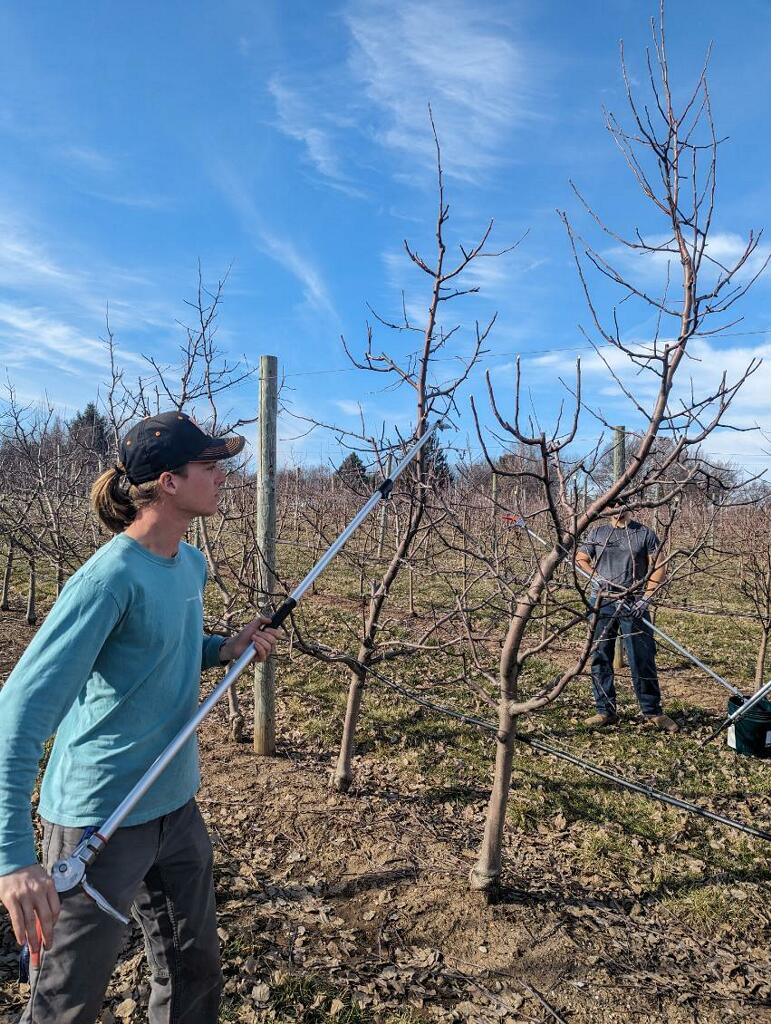With a cold and snowy January behind us, it’s time to look towards the next step in caring for our fruit trees, pruning. February is the perfect time to prune pome fruits like apples, pears, and quince. While it can seem daunting to an initiate just getting into fruit tree cultivation, pruning is necessary for the overall health of your trees.
Properly pruning your fruit trees have many benefits
- It opens up the trees canopy, allowing for better airflow, which in turn cuts down on insect and disease pressure.
- By removing superfluous branching, you channel the trees energy to branches that create more fruit.
- With better sunlight penetration into the canopy, the tree creates more fruit.
- Helps with more even coverage of applications of insecticides and fungicides.
- By controlling the trees overall size, making harvesting your fruits easier!
Before you start, it’s always recommended to thoroughly clean and sharpen your pruning implements. Dull pruning equipment not only makes your job harder, but it also leaves less clean cuts on the tree, which can lead to insect or disease entry points later in the season.
The Importance of Sanitizing
When pruning fruit trees, I must stress how important it is to sanitize your pruning equipment before and after each tree. We can unknowingly transmit diseases amongst our trees, so sanitizing our equipment is a necessity. A simple 9:1 solution of 9-parts water to 1-part isopropyl alcohol or bleach works well! Dunk your pruners into this solution for 15-30 seconds after each tree, use a spray bottle with this solution to spray on saw blades.
What to Prune
Regardless of the style you grow your fruit trees, these are the types of removal that need to be done every year.
- The 4-D’s- if the branch is Dead, Dying, Diseased or Damaged. This can be done at any time of the year, but definitely should be done at this point.
- Any branches that are crossing or rubbing against one another. Pick the stronger of the two branches and remove the weaker one.
- Waterspout branches- these typically come from heavily pruned trees and as a response the trees tend to create them to aid in photosynthesis. Thin them out or remove them.
- Any branches that grow directly towards the main trunk.
- Any branches that grow directly downwards.
Even if no other pruning is done, this will substantially increase productivity and overall plant health!
Spraying your Tree
After pruning your fruit tree, this is the perfect time to do the first application of spray to your fruit tree of the year. Since most of the fungus that affect fruit trees do not get killed off by winter temperatures, it’s best to eradicate them before they come back when conditions become favorable. I recommend using a blend of Bonide Dormant Oil and Bonide Copper Fungicide, mixed to the manufacturer’s specifications. This is an organic option that will kill overwintering insect eggs and diseases.
To Recap
I hope that this gives a good understanding of why pruning and spraying your fruit trees is so important at this time of the year. By doing a little extra work now, we’re setting ourselves up for better tree health down the road, as well as an increased harvest later this year. As always, if you have any questions, please feel free to stop by Colonial Gardens and let us help you with all your plant health solutions!
Thanks for your thyme!
Written By "Trav the Tree Guy" Travis Morcha
.jpg)

